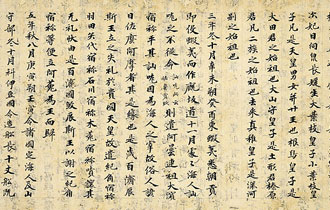Pages |
The special makeup and costume, the special walk and sound are among the many kinds of show stoppers. Another occurring in every kabuki and by now a familiar part of the Japanese vocabulary is the mie. As in the case of the asides, the actor stands still and comes to a complete stop. He then assumes his pose, that is, he rolls his head around a little, glares, and then crosses one eye. This you will see. The sound of the ki clapping makes it clear that the audience should pay attention. Ki clappers are, two wooden, rectangular blocks, which a man strikes against the floor of the stage at the side to announce either the beginning of a play or a dramatic or emotionally charged moment. One can easily say that there is no hesitancy in kabuki about interrupting the dramatic action and attracting the audience's attention toward an engaging moment. There are acrobatics.
The sets for kabuki are sometimes spectacular and the stage extraordinarily flexible-in one production a complete roof turns over to reveal another story of the building, in many productions the stage moves around so that it is possible for you to be viewing the action in the interior of a room and suddenly find the entire stage turn around so that you are looking at action in the woods, or at the sea, or on a road. In other productions, such as in Yoshitsune senbonzakura (Yoshitsune and the Thousand Cherry Trees), actors use trap doors to capture our attention or the device that carries an actor over the heads of the audience. In a popular contemporary kabuki play, Yamato Takeru (named for a famous Japanese mythological figure), Ennosuke, one of the most famous contemporary performers, actually flies over the heads of the audience.
The kabuki theater is not dependent for success on a connected text and development of plot and character, but is a theater dependent for success on actors and the techniques and accoutrements that make them worth watching. In the West there is opera, during which the audience waits for the arias and musical numbers and enjoys the sets, the costumes, and the props, including live animals sometimes seen on stage, rather than plot as in traditional western theater. However, since the opera singers do not step out of character to speak as the kabuki actors will do, there still remains a difference between traditional serious western drama and Japanese kabuki. There are comic scenes in kabuki, in which asides are expected, but I am not referring to these but rather to the serious and tragic side of the drama.
In part, this difference can be explained by the close connection between kabuki and bunraku, the traditional puppet theater of Japan, which was a theatrical form contemporary with kabuki. In the bunraku theater the puppets cannot speak for themselves; instead, a narrator, gidayū, accompanied by a shamisen, speaks for them. As often as not the gidayū will give the audience the background to the story or talk about a character, as if the performance were not a play. What happened in the history of kabuki is that in the hands of Chikamatsu Monzaemon (1653-1724), probably the greatest playwright of both kabuki and bunraku plays, the practices of bunraku passed over to kabuki and vice-versa to such an extent that in some kabuki plays a gidayū speaks for the kabuki actors as if they were dolls and the dolls of bunraku are manipulated in a way that makes them seem like live human beings. In the case of kabuki, the effect of the practice of using the narrator's voice is to remove the actors from the characters at moments of intense emotional outpouring by not allowing them to speak. In one sense this practice is the opposite of the actor removing himself from the character to discuss trade relations, but in another the same, since it has a similar effect. The audience cannot become involved in the characters in the same way they do in a Western drama like Oedipus the King, a Greek tragedy written by Sophocles.
Pages |











